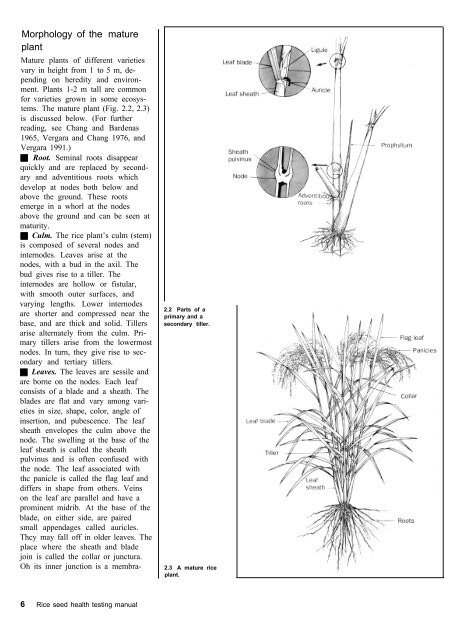A manual of rice seed health testing - IRRI books - International Rice ...
A manual of rice seed health testing - IRRI books - International Rice ...
A manual of rice seed health testing - IRRI books - International Rice ...
- No tags were found...
Create successful ePaper yourself
Turn your PDF publications into a flip-book with our unique Google optimized e-Paper software.
Morphology <strong>of</strong> the mature<br />
plant<br />
Mature plants <strong>of</strong> different varieties<br />
vary in height from 1 to 5 m, depending<br />
on heredity and environment.<br />
Plants 1-2 m tall are common<br />
for varieties grown in some ecosystems.<br />
The mature plant (Fig. 2.2, 2.3)<br />
is discussed below. (For further<br />
reading, see Chang and Bardenas<br />
1965, Vergara and Chang 1976, and<br />
Vergara 1991.)<br />
Root. Seminal roots disappear<br />
quickly and are replaced by secondary<br />
and adventitious roots which<br />
develop at nodes both below and<br />
above the ground. These roots<br />
emerge in a whorl at the nodes<br />
above the ground and can be seen at<br />
maturity.<br />
Culm. The <strong>rice</strong> plant’s culm (stem)<br />
is composed <strong>of</strong> several nodes and<br />
internodes. Leaves arise at the<br />
nodes, with a bud in the axil. The<br />
bud gives rise to a tiller. The<br />
internodes are hollow or fistular,<br />
with smooth outer surfaces, and<br />
varying lengths. Lower internodes<br />
are shorter and compressed near the<br />
base, and are thick and solid. Tillers<br />
arise alternately from the culm. Primary<br />
tillers arise from the lowermost<br />
nodes. In turn, they give rise to secondary<br />
and tertiary tillers.<br />
Leaves. The leaves are sessile and<br />
are borne on the nodes. Each leaf<br />
consists <strong>of</strong> a blade and a sheath. The<br />
blades are flat and vary among varieties<br />
in size, shape, color, angle <strong>of</strong><br />
insertion, and pubescence. The leaf<br />
sheath envelopes the culm above the<br />
node. The swelling at the base <strong>of</strong> the<br />
leaf sheath is called the sheath<br />
pulvinus and is <strong>of</strong>ten confused with<br />
the node. The leaf associated with<br />
thc panicle is called the flag leaf and<br />
differs in shape from others. Veins<br />
on the leaf are parallel and have a<br />
prominent midrib. At the base <strong>of</strong> the<br />
blade, on either side, are paired<br />
small appendages called auricles.<br />
Thcy may fall <strong>of</strong>f in older leaves. The<br />
place where the sheath and blade<br />
join is called the collar or junctura.<br />
Oh its inner junction is a membra-<br />
2.2 Parts <strong>of</strong> a<br />
primary and a<br />
secondary tiller.<br />
2.3 A mature <strong>rice</strong><br />
plant.<br />
6 <strong>Rice</strong> <strong>seed</strong> <strong>health</strong> <strong>testing</strong> <strong>manual</strong>

















